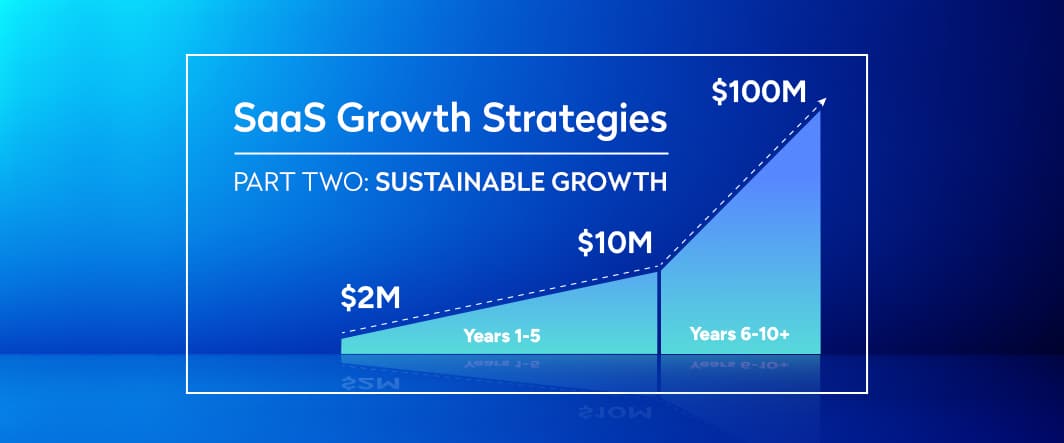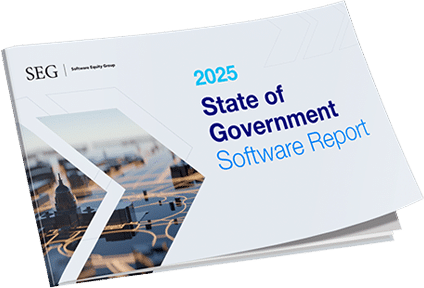8 Proven Marketing Strategies for Sustainable Growth

In Part One of this two-part series, I presented the first eight marketing strategies to help get companies from the early stages to at least $10M in ARR. While those strategies provide a firm foundation to build your marketing efforts, they aren’t enough to propel your business to the next level.
Once SaaS companies have reached around $10M ARR, their marketing initiatives need a more strategic and technical approach, often requiring the help of an expanded marketing team. It is no longer about casting a wide net and hoping for the best. Now, it’s time to focus on optimizing each stage of the marketing funnel by analyzing strengths and identifying areas for improvement.
Scaling ARR to $100M and Beyond
This was the situation we faced at iOffice. After hitting $12M in ARR, our founders decided to consider equity recapitalization to drive next-level growth. For some time before this, our CEO informally checked in with SEG to gain insights into which metrics would maximize our enterprise value (EV). With extremely strong financial metrics, an excellent Rule of 40 ratio, and solid EBITDA , SEG agreed we were on the right track and guided us wisely through a process culminating in the transaction to Waud Capital in 2017.
During the transition, I remained the VP of Marketing while a new leadership team, including a CEO, CTO, CFO, and VP of Sales, were brought on board. Our focus during this phase was on scaling the business through organic growth and an aggressive M&A strategy.
Below are the marketing initiatives that enabled us to grow significantly over the ensuing three years.
1. Refined Target Audiences
As the business organically grew and we added acquisitions to our portfolio, the marketing team needed to refine its target audience and identify our ideal customer profile (ICP) for new segments. To better understand the target market’s needs, we conducted market research, analyzed existing customer data in our CRM, and interviewed clients. We built two dozen robust buyer personas and developed key messaging for each with that information.
By clearly defining our ideal customers, we were able to create marketing campaigns that resonated and helped move them through the funnel. This led to lower customer acquisition costs (CAC) through better conversion rates and ultimately increased revenue.
2. Built a Talented Team
With investment dollars and significant business goals came the need to build a team to execute the strategy effectively. We strongly emphasized hiring the right people and holding them accountable. Our hiring process included behavioral interviews, case study assignments, and peer reviews. We also invested in training tracks, providing mentorship, and access to learning resources. Each team member had specific job duties and was provided a set of metrics they were responsible for attaining. We met regularly to discuss performance and ways to improve.
Many marketing departments work in silos – I encouraged cross-functional collaboration with sales, product development, and customer success. This collaborative approach helped ensure marketing efforts aligned with business objectives and the organization was working towards a common goal. As a result of these efforts, we built a highly effective marketing team that could consistently deliver solid results and drive business growth.
USE this TEMPLATE TO CREATE an IDEAL CANDIDATE PROFILE FOR YOUR MARKETING POSITIONS:

3. Increased Brand Awareness
Along with developing strong brand messaging that resonated with our audiences and leveraging digital channels to reach a wider audience, my team increased brand awareness through targeted advertising, content marketing, social media, and other channels. With so many SaaS companies competing for attention, we knew we needed to work diligently to differentiate ourselves effectively and establish a strong brand identity.
Podcasts are an effective way to increase awareness by providing a platform for thought leadership, community building, brand exposure, and industry insights. By creating a podcast relevant to our target audience, we were able to solidify ourselves as thought leaders in the PropTech industry and build trust with potential customers. Fortunately, we had an amazing podcast host who amplified our brand with his weekly shows. After a strategic acquisition, he added a second podcast that helped us gain credibility quickly with this new audience.
4. Developed GTM Strategies
By developing a well-crafted go-to-market strategy, SaaS companies can ensure their new product is launched successfully and reaches their target audience effectively. It can also minimize risks and optimize resources by focusing on the most effective marketing and sales tactics for the target audience.
Prior to being acquired, we had a marketing strategy with several campaigns that marketing worked on and owned. After Waud purchased iOffice, we had an entire executive team that was aligned with company objectives. Now we could create comprehensive go-to-market (GTM) strategies for new products.
Developing a GTM strategy requires a deep understanding of:
- The market you serve
- Deep product understanding
- Deep persona/ICP understanding
- Behavioral analytics
- Competitor analysis
- Positioning
- Pricing
To tap into all this experience and attain true success, you need cross-functional stakeholder management — sales, product, marketing, and sometimes customer support all have active roles to play.
If you want to learn more about GTM best practices, sign up for our live webinar on April 20th. Our panel comprises leaders well-versed in go-to-market operations for SaaS businesses of all types, from bootstrapped startups to PE-backed and publicly traded companies.
5. Invested in MarTech
The MarTech landscape constantly evolves with new tools and technologies being developed and enhanced. According to MarTech.org, there were over 9,932 MarTech tools and platforms available as of 2022.
At iOffice, we leveraged tools to improve efficiency and productivity and augment processes throughout the customer lifecycle. Solutions like ABM platforms, chatbots, and inbound lead conversion platforms significantly impacted marketing ROI and helped streamline operations, automate tasks, and improve decision-making.
Here are some of the MarTech tools we used:

And here are just a few examples of how these MarTech tools helped:
- Zoominfo’s form complete helped with user experience by auto-populating data after visitors filled out just one or two fields. This increased conversion rates across all websites by up to 27%.
- We used the calendar integration to immediately book calls with business development representatives (BDRs) instead of prospects having to email back and forth with sales.
- Techvalidate allowed us to send surveys to our existing client base and collect, analyze, and publish customer case studies, testimonials, and other marketing content. This tool helped us build credibility and generate demand through authentic customer proof points.
6. Focused on Customer Retention
We invested in customer retention strategies to minimize churn and maximize the lifetime value of our customers. The team developed customer loyalty programs, implemented customer feedback programs, and provided exceptional customer support, ultimately significantly increasing customer lifetime value and contributing to our overall business growth.
Our customer marketing manager worked closely with Product, which owned our Customer Advisory Board (CAB). To gain insight and knowledge, this group met with 20+ customers four times a year about product roadmap, industry challenges, and beta releases to gain insight and knowledge. This helped us understand our customers better and build stronger relationships, ultimately leading to increased customer retention and growth.
We also put on an annual customer appreciation event, with speakers, tech stations, and entertainment. The goal of this event was not to sell to customers but to create a platform for us to listen to them and understand their needs. Our first event had 30 customers and grew to nearly 500 by the third year. This event alone generated an almost 500% increase in pipeline and a 377% increase in return on investment (ROI).
7. Marketing & Sales Alignment
Marketing and sales work hand-in-hand—marketing to create content that attracts prospects and captures leads; sales to nurture those leads and convert them into customers.
Even before selling iOffice, our marketing team was attracting many leads for our sales team to work with, but we still didn’t have a cohesive sales and marketing strategy. We wasted resources by duplicating efforts and undermined our brand when marketing and sales approached prospects with different messaging. Once we had an established sales leader, we worked with sales to create a cohesive strategy aligned with the company’s goals.
The sales leader and I met weekly to create processes and set clear communication channels for sharing insights, feedback, and data. Together, we established key performance indicators (KPIs) that measured the success of both teams’ efforts, analyzed pipeline performance, and pinpointed to optimize campaigns. In addition to saving time and resources, our combined efforts resulted in a 380% increase in annual contract value (ACV).
8. Tracked & Reported Marketing Results
In the previous blog, I mentioned I’m very analytical — a necessary trait for your marketing leader. I love numbers and metrics — especially when they go up and to the right! We collected data on marketing activities and campaigns using tools such as Google Analytics, our CRM, SalesForce, and our marketing automation platform, HubSpot.
Then, we created a dashboard that displayed the KPIs and allowed us to track progress toward our marketing goals and objectives. This was one of the dashboards the sales leader and I discussed regularly. I also used this dashboard to report on the teams’ performance during my 1:1’s with our CEO.
CEOs don’t care about how many social posts you write, webpages you publish, or impressions and visitors you have. CEOs typically want to know the overall impact of marketing efforts on the business, including metrics such as revenue attribution, customer acquisition costs (CAC), and ROI. They also want to understand the effectiveness of individual campaigns and channels. My rule of thumb was if I put budget dollars towards it, I tracked its ROI.
All this tracking and reporting allowed us to understand which channels were working and which weren’t and move budget dollars to the more profitable ones. Overall, this strategy resulted in a 22% decrease in CAC.
M&A Strategy + Organic Growth = $100M+
Over three years, our marketing efforts combined with an M&A strategy helped us achieve very significant ARR. At that point, we worked with SEG to help us exit once again. In 2021, Thoma Bravo acquired iOffice for an undisclosed amount. Shortly after, I left the company and became a fractional CMO for SEG. My consulting role eventually led me to a permanent position within the company.
At iOffice, I made an impact on one company. In my new role, I can share my marketing expertise with hundreds of SaaS organizations. Over the next few years, I aim to empower software executives with the correct data and resources to improve business performance, maximize valuations, and provide a reliable SaaS growth strategy.
If you’re looking for more insights on how to use marketing to scale your SaaS company, connect with me on LinkedIn. I regularly share insights and trends aimed at boosting valuations and facilitating smoother exits.










